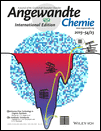Revealing the Charge-Transfer Interactions in Self-Assembled Organic Cocrystals: Two-Dimensional Photonic Applications†
We sincerely thank Dr. Libo Du for ESR measurements, Dr. Ye Zou for XPS analysis, Xuedong Wang for PLQY measurements, and Zhenyi Yu for PL lifetime characterizations. This work was supported by the National Natural Science Foundation of China (51303185, 21021091, 51033006, 51222306, 51003107, 61201105, 3591027043, 91222203, 91233205, 21473222), the China-Denmark Co-project, TRR61 (NSFC-DFG Transregio Project), the Ministry of Science and Technology of China (2011CB808400, 2011CB932300, 2013CB933403, 2013CB933500, 2014CB643600), and the Chinese Academy of Sciences (the Strategic Priority Research Program, Grant No. XDB12020300).
Graphical Abstract
Crystal clear: A new crystal of a donor–acceptor (D–A) complex was prepared and it has a two-dimensional morphology. The charge-transfer interactions were fully investigated. This organic cocrystal has unique two-dimensional optical waveguide properties, and has potential applications in next-generation optoelectronic communications.
Abstract
A new crystal of a charge-transfer (CT) complex was prepared through supramolecular assembly and it has unique two-dimensional (2D) morphology. The CT nature of the ground and excited states of this new Bpe-TCNB cocrystal (BTC) were confirmed by electron spin resonance measurements, spectroscopic studies, and theoretical calculations, thus providing a comprehensive understanding of the CT interactions in organic donor–acceptor systems. And the lowest CT1 excitons are responsible for the efficient photoluminescence (ΦPL=19 %), which can actively propagate in individual 2D BTCs without anisotropy, thus implying that the optical waveguide property of the crystal is not related to the molecular stacking structure. This unique 2D CT cocrystal exhibits potential for use in functional photonic devices in the next-generation optoelectronic communications.





